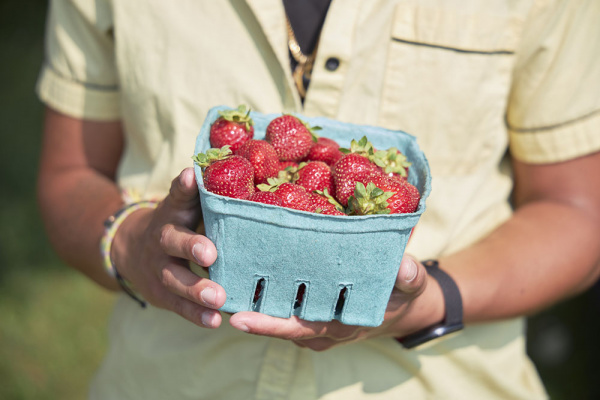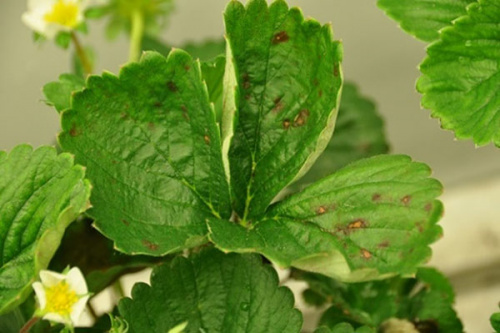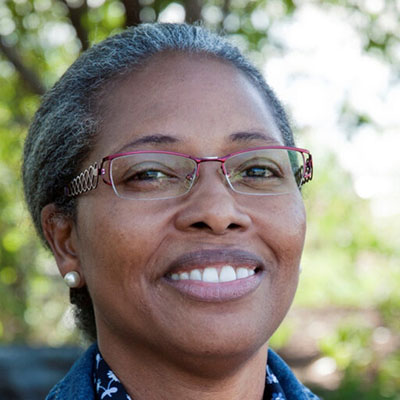For more information
Media Relations
Agriculture and Agri-Food Canada
1-866-345-7972
aafc.mediarelations-relationsmedias.aac@agr.gc.ca
In Canada, one third of fruits and vegetables are lost every year to fungal or bacterial diseases. To help producers that grow vegetables in greenhouses or tunnels, a team of scientists from Agriculture and Agri-Food Canada (AAFC) has been studying a sustainable, pesticide-free approach that can help plants combat these diseases.
Strawberries were one of the crops tested, along with lettuce and tomatoes. Strawberries rank sixth among the fruit grown in all provinces. Its production in Canada totalled 24,158 metric tons in 2020. Quebec ranks third in North American strawberry production after California and Florida, and first in Canada. With a growing market for greenhouse strawberries, scientific research on the topic is of the utmost importance.
The project was led by Marie Thérèse Charles, a scientist at AAFC’s Saint-Jean-sur-Richelieu Research and Development Centre (RDC), in collaboration with other researchers from AAFC, the Université de Sherbrooke and international universities. Based on their studies of tomato, lettuce and strawberry, the team achieved two major scientific breakthroughs in the fight against fungal and bacterial diseases. The main objective of these research activities was to test a viable alternative to pesticides.
“The overuse of synthetic pesticides may lead to the development of pathogen resistance, compounding the problem to be solved. It is important that growers wishing to reduce the application of chemical pesticides have sustainable alternative options. Our work shows that low-dose UV treatments that activate plants’ natural defences can be counted among these alternatives.”
– Marie Thérèse Charles, scientist at AAFC’s Saint-Jean-sur-Richelieu RDC.
The first milestones of this research project
Nearly 40 years ago, American, Canadian and Israeli scientists independently demonstrated that ultraviolet light (UV-C) could control post-harvest disease in fresh fruit and vegetables. UV-C treatments were seen as a viable alternative to reducing reliance on synthetic pesticides. Unfortunately, for this treatment to be effective, the fruit or vegetable had to be exposed in its entirety. This meant turning them so they could be exposed from every angle. Knowing how fragile some of these products are, it was difficult to do this without damaging them.
In 2009, Marie Thérèse Charles’ research team looked into the problem and proposed treating the whole plant before harvest. After some preliminary trials, they found that it was more advantageous to apply treatment continuously during part of the plant’s development. What a paradigm shift! All the established parameters were about to be changed. They had to find the right dose and duration of treatment, specific to each of the species they had chosen as a model for achieving the beneficial responses they were seeking.
Creation of a pilot system for treating strawberries in greenhouses
As part of their research, the team discovered that exposing growing strawberry plants to UV-C improved their ability to defend themselves against disease. As UV-C rays are a component of solar radiation, it is safe for humans to consume strawberries that have been exposed to them.
To study the impact of ultraviolet rays, the team modified a growth chamber by adding neon lights emitting UV-C at a wavelength of 254 nanometers. Working with specialized electronics and the engineering team at AAFC, they were able to develop a first-generation pilot system that could be used to treat plants in greenhouses.
After receiving low doses of radiation, the plants are able to withstand light stress and strengthen their own defences. Scientists had to establish the precise dose of UV-C rays and the frequency of repetition of the treatment that would produce the expected beneficial responses. If the dose is too high, growth is adversely affected and the harvest decreases. In fact, overexposure to UV-C damages plants, just as overexposure of the skin to the sun’s rays causes sunburn. The team also demonstrated that low doses of UV-C rays do not have a negative impact on fruit quality. So, you'll be able to harvest big, juicy strawberries!

A surprising discovery about the strawberry plant’s self-defence system
The second discovery is a real breakthrough in strawberry research! Scientists were able to observe and accurately describe how the strawberry plant manages to improve its own self-defence system. When specific types of genes are stimulated, they inform the plants to activate their defence system. The plants then create their own barrier against pathogens by reinforcing their leaf surface structure. It then becomes extremely difficult for diseases, such as the fungus that causes common leaf spot, to enter the leaves and infect them. In addition, other molecular components of plants become active and act as antifungal or antibacterial agents.

|

|
Strawberry plants artificially inoculated with the fungus Mycosphaerella fragariae. The fungus causes common leaf spot disease in strawberries. The photo on the left shows the untreated control leaves. The photo on the right shows the leaves of a plant treated with UV-C. A significant reduction in the number of spots can be seen.
What does the future hold for other fruits and vegetables?
Once the commercial-scale studies have been completed, this eco-friendly method using a low dose of UV-C rays to preserve crops will offer huge potential for greenhouse and field strawberry production, particularly for the organic sector, because it will reduce the use of pesticides to combat fungal and bacterial diseases. This method is also promising for other fruit and vegetable growers.
With such scientific advances, all you have to do is find your family recipes for strawberry shortcake, pie and jam to rediscover this much loved red fruit!

A specialist in post-harvest physiology, scientist Marie Thérèse Charles works at the Saint-Jean-sur-Richelieu Research and Development Centre (RDC). Since joining Agriculture and Agri-Food Canada (AAFC) in 2001, she has led research projects on physical treatments (pre-harvest and post-harvest) for the growth, improvement and disease control of fresh fruits and vegetables. Marie Thérèse and her team are developing clean technologies, such as UV treatment technologies, to reduce the use of agrochemicals in the industry. She was also involved in the Three Sisters research project (corn, squash and beans), a collaborative project with the Wendake Indigenous community, to evaluate the production of heirloom varieties to identify food and marketing opportunities for First Nations. Learn more about her research projects: Marie Thérèse Charles | Directory of Scientists and Professionals (science.gc.ca)
Key Discoveries/Benefits
- As part of their research, the team discovered that exposing growing strawberry plants to UV-C improved their ability to defend themselves against disease.
- The team also demonstrated that low doses of UV-C rays do not have a negative impact on fruit quality.
- Scientists were able to observe and accurately describe how the strawberry plant manages to improve its own self-defence system.